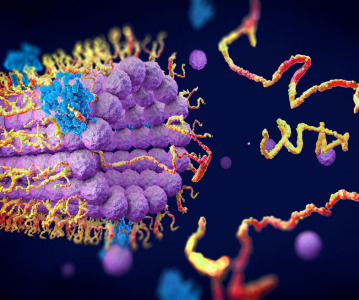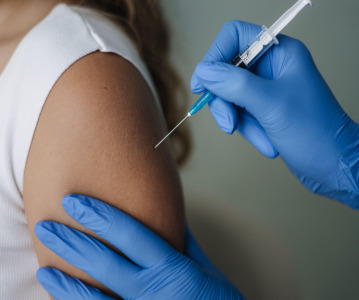Breakthrough Antibacterial Approach Could Resolve Serious Skin Infections

Like a protective tent over a colony of harmful bacteria, biofilms make the treatment of skin infections especially difficult. Microorganisms protected in a biofilm pose a significant health risk due to their antibiotic resistance and recalcitrance to treatment, and biofilm-protected bacteria account for some 80% of total bacterial infections in humans and are 50–1000 times more resistant to antibiotics than simpler bacterial infections.
“In essence, we may have stumbled onto a magic bullet,” said David Fox, a Los Alamos National Laboratory researcher on the project. “Through a robust screening strategy, our research team has identified a unique class of materials, known as ionic liquids, which both neutralize biofilm-forming pathogens and deliver drugs through the skin,” he said.
“We extended our current capability in antimicrobial platforms with ionic liquids to new heights by partnering with Dr Mitragotri at UCSB, who is an expert in transdermal drug delivery platforms. The merger made perfect sense,” stated Fox.
“In several cases, we found the ionic liquid was more efficacious on a biofilm than a standard bleach treatment and exhibited minimal cytotoxicity effects on human cell lines (unlike bleach). This has excellent prospects for aiding antibiotic delivery to the pathogen through biofilm disruption but, most interestingly, the ionic liquids themselves are quite effective for pathogen neutralisation,” Fox said.
This work could have especially useful applications for military medical treatments, he noted, where soldiers in the field can be exposed to bacterial infections that are particularly difficult to treat.
Biofilms often persist in the periphery of an actual wound, beneath an intact, healthy skin layer and the difficulty of their treatment is largely due to the outermost layer of the skin, the stratum corneum, being a natural barrier for drug delivery.
“If the bacterial biofilm can be disrupted, delivery of antibiotics is greatly enhanced, and any dispersed pathogens are generally restored to normal antibiotic susceptibility,” said Fox. “Further, many bacterial infestations in wounds penetrate under the outer skin layer, the stratum corneum, and deep into the tissue (epidermis and dermis). These materials are able to penetrate through the skin and effectively carry antibiotics to the deepest layers.”
“Clearly, the ionic liquids would be of special benefit to our warfighters where exposure to biological agents in hostile environments is likely. Topical application as a prophylaxis or direct treatment to an open wound could buy enough time to reach the proper medical facilities when in an austere environment,” he said. Importantly, ionic liquids can be derived from very cheap starting materials that are FDA approved and are extremely stable to high temperatures and pressures, which are necessary traits for commercialisation in real-world applications.
In a groundbreaking manuscript appearing this week in the Proceedings of the National Academy of Science, as part of a multi-institutional effort between Los Alamos, University of California Santa Barbara, Dixie State University and Northern Arizona University, researchers explored exploiting ionic liquids both in a concerted effort to combat antibiotic-resistant bacterial biofilms in skin, as well as for topical transdermal drug delivery. The comprehensive strategy resulted in the identification of ionic liquids that are effective at disrupting biofilms, neutralizing pathogens, and enhancing delivery of antibiotic into skin.
Biofilms are a major cause of chronic wounds and wound degeneration. Wounds from infected surgical incisions result in 1 million additional hospital days. Additional causes of bacterial infected wounds include traumatic injuries, as well as diabetic foot ulcers, venous leg ulcers, and pressure ulcers.
The total economic burden of skin disease was estimated to be approximately $96 billion in 2004, and the prevalence and healthcare costs for skin disease have been increasing over the last three decades. Bacterial infections in the skin are among the most common diagnoses in hospital patients, accounting for some 10% of all hospital visits. Staphylococcus aureus infections acquired in hospitals, which account for only 16% of nosocomial infections, are estimated to result in $9.5 billion in extra patient costs and 12,000 deaths annually.
The comprehensive approach is unique in that the team examined a panel of in-house synthesized ionic liquids and enabled the discovery of one ionic liquid, choline-geranate, which showed excellent antimicrobial activity, minimal toxicity to epithelial cells as well as skin, and effective permeation enhancement for drug delivery. Specifically, choline-geranate was comparable with, or more effective than, bleach treatment against established biofilms of Salmonella enterica and Pseudomonas aeruginosa, respectively. In addition, choline-geranate increased delivery of cefadroxil, an antibiotic, by >16-fold into the deep tissue layers of the skin without inducing skin irritation.
Related News
-
News A Day in the Life of a Start-Up Founder and CEO
At CPHI we work to support Start-Up companies in the pharmaceutical industry and recognise the expertise and innovative angles they bring to the field. Through our Start-Up Programme we have gotten to know some of these leaders, and in this Day in the ... -
News Biopharmaceutical manufacturing boost part of new UK government budget
In their national budget announced by the UK Labour Party, biopharmaceutical production and manufacturing are set to receive a significant boost in capital grants through the Life Sciences Innovative Manufacturing Fund (LSIMF). -
News CPHI Podcast Series: The power of proteins in antibody drug development
In the latest episode of the CPHI Podcast Series, Lucy Chard is joined by Thomas Cornell from Abzena to discuss protein engineering for drug design and development. -
News Amgen sues Samsung biologics unit over biosimilar for bone disease
Samsung Bioepis, the biologics unit of Samsung, has been issued a lawsuit brought forth by Amgen over proposed biosimilars of Amgen’s bone drugs Prolia and Xgeva. -
News CPHI Podcast Series: Why we need to consider women in clinical trials
The latest episode of the CPHI Podcast Series with Lucy Chard covers women's health, specifically women's representation in clinical trials, the associated bias, and the impacts on health for this population. -
News US FDA does not approve MDMA therapy for PTSD, requests more data
The MDMA-based therapeutic developed by Lykos Therapeutics, a California-based Public Benefit Corporation (PBC), has been reviewed and unapproved by the US FDA. The regulator has requested additional phase III trial data for further safety and efficacy... -
News Novartis and Viatris latest facing lawsuit over HeLa cell misuse
Global pharmaceutical companies Novartis and Viatris are the latest hit with a lawsuit claim pertaining to alleged misuse of the ‘HeLa’ cell line from the estate of woman whose cancerous tissue cells were taken without consent. -
News Sanofi invests billions into Frankfurt insulin production site
French pharmaceutical company Sanofi have announced an investment of EUR1.3 billion at their existing BioCampus site in Frankfurt am Main for the expansion of insulin production.
Position your company at the heart of the global Pharma industry with a CPHI Online membership
-
Your products and solutions visible to thousands of visitors within the largest Pharma marketplace
-
Generate high-quality, engaged leads for your business, all year round
-
Promote your business as the industry’s thought-leader by hosting your reports, brochures and videos within your profile
-
Your company’s profile boosted at all participating CPHI events
-
An easy-to-use platform with a detailed dashboard showing your leads and performance



.png)

.png)
.png)
.png)